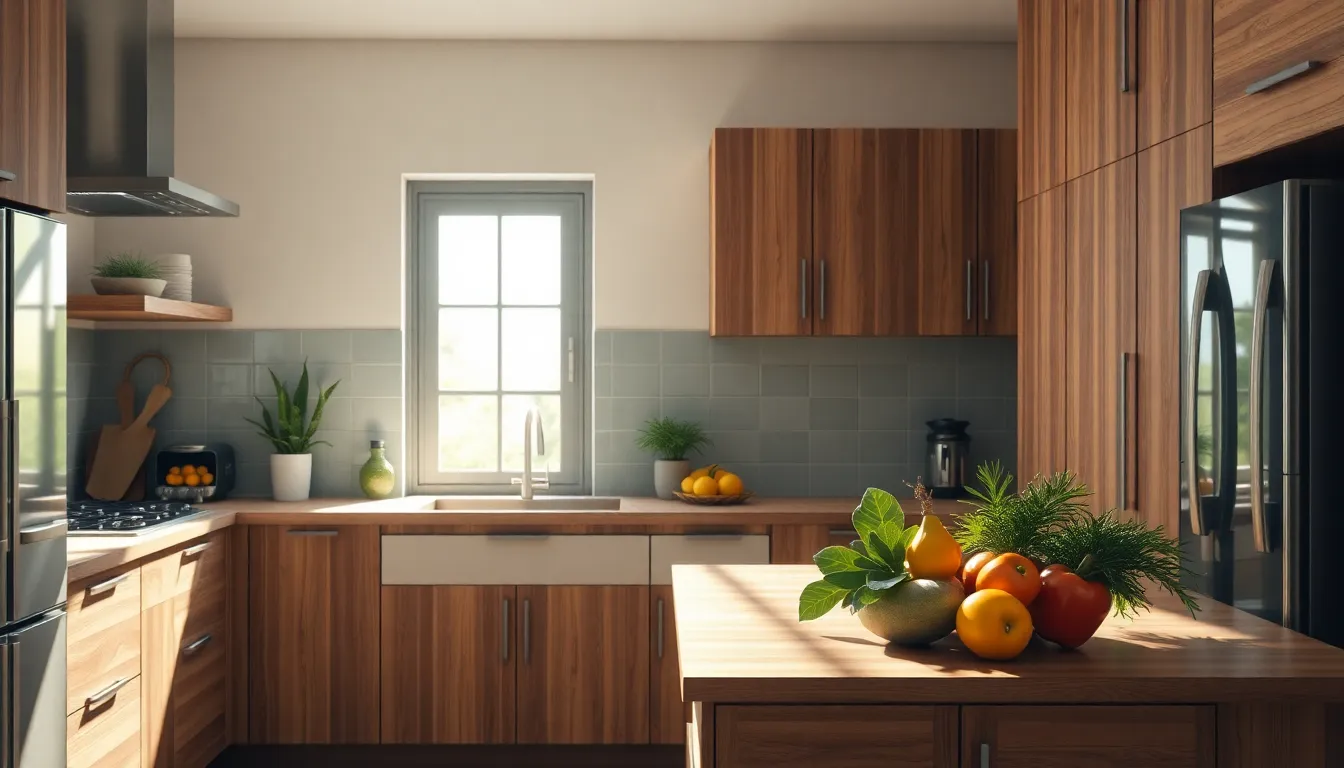Creating an eco-friendly kitchen isn’t just a trend; it’s a lifestyle choice that benefits both the planet and its inhabitants. With growing awareness about climate change and sustainability, more people are looking for ways to reduce their environmental impact right from their homes. A kitchen, often the heart of the household, presents a perfect opportunity to make eco-conscious decisions.
From energy-efficient appliances to sustainable materials and waste reduction strategies, transforming a kitchen into an eco-friendly space can be both practical and stylish. By making small changes, anyone can contribute to a healthier environment while enjoying the benefits of a greener lifestyle. Embracing these practices not only enhances the kitchen’s functionality but also promotes a sense of responsibility towards the Earth.
Table of Contents
ToggleWhat Is an Eco-Friendly Kitchen?
An eco-friendly kitchen incorporates sustainable practices and materials to reduce environmental impact. It prioritizes energy efficiency, water conservation, and waste reduction while creating a healthy cooking environment.
Energy-Efficient Appliances
Energy-efficient appliances use less electricity, lowering utility bills and carbon footprints. Selecting appliances with the ENERGY STAR label guarantees energy savings. Examples include refrigerators, dishwashers, and ovens designed for efficiency.
Sustainable Materials
Sustainable materials reduce ecological harm. Choices like bamboo, reclaimed wood, and recycled metal create a unique aesthetic while being environmentally responsible. Opting for non-toxic finishes and low-VOC paints improves indoor air quality.
Waste Reduction Strategies
Implementing waste reduction methods minimizes landfill contributions. Composting kitchen scraps, using reusable containers, and recycling can significantly decrease waste. Programs that promote bulk purchasing and minimal packaging support sustainable practices.
Water Conservation Techniques
Water conservation techniques enhance sustainability. Installing low-flow faucets and efficient dishwashers minimizes water use. Collecting rainwater for gardening or using water-efficient appliances significantly conserves this vital resource.
An eco-friendly kitchen embodies a lifestyle choice that promotes environmental health. Each element—from energy efficiency to sustainable materials—contributes to a kitchen that serves both functional and ecological purposes.
Benefits of an Eco-Friendly Kitchen

An eco-friendly kitchen offers numerous advantages that benefit both the environment and personal health. Adopting sustainable practices in the kitchen can lead to long-term savings and improved quality of life.
Reducing Carbon Footprint
Reducing the carbon footprint starts with using energy-efficient appliances designed to consume less electricity. Appliances with the ENERGY STAR label contribute to lower greenhouse gas emissions, fostering climate stability. Opting for renewable energy sources, such as solar or wind, further minimizes reliance on fossil fuels.
Choosing local, seasonal produce also significantly cuts transportation emissions. It reduces the energy used in shipping and packaging, supporting community agriculture. Implementing waste reduction strategies, including recycling and composting, prevents organic materials from decomposing in landfills, resulting in methane emissions – a potent greenhouse gas.
Health Benefits
An eco-friendly kitchen promotes health through improved indoor air quality. Non-toxic finishes on cabinets and countertops reduce exposure to harmful volatile organic compounds (VOCs). Selecting sustainable materials, like bamboo or reclaimed wood, often entails fewer chemicals, benefiting both occupants and the planet.
Using energy-efficient appliances can lower electric bills, providing financial relief while maintaining comfort. Water efficiency measures, such as installing low-flow faucets, not only conserve resources but also enhance water quality by minimizing contaminants associated with high water usage.
Cooking with fresh, organic ingredients supports a healthier diet. These foods typically contain fewer pesticides and additives, contributing to better overall health. An eco-friendly kitchen fosters a lifestyle that values both personal well-being and environmental stewardship.
Key Elements of an Eco-Friendly Kitchen
Creating an eco-friendly kitchen involves specific choices that prioritize sustainability, efficiency, and minimal waste. The following components are essential in achieving an environmentally responsible cooking space.
Sustainable Materials
Sustainable materials enhance both the kitchen’s aesthetic and environmental footprint. Bamboo, reclaimed wood, and recycled metal serve as excellent choices due to their renewability and low environmental impact. Additionally, countertops made from recycled glass or sustainable stones offer durability while reducing resource extraction. Non-toxic finishes, such as eco-friendly paints and sealants, contribute to improved indoor air quality, further promoting a safe cooking environment.
Energy-Efficient Appliances
Energy-efficient appliances play a crucial role in reducing energy consumption. Look for appliances labeled with the ENERGY STAR certification, which guarantees lower energy use and cost savings. Refrigerators, dishwashers, and ovens designed for efficiency operate effectively while reducing greenhouse gas emissions. Incorporating smart technology can optimize energy use, allowing for remote control and monitoring of appliances for enhanced efficiency.
Waste Reduction Strategies
Effective waste reduction strategies minimize kitchen contributions to landfills. Implementing composting systems for organic waste decreases overall waste volume. Utilizing reusable containers and shopping bags reduces reliance on single-use plastics. Establishing dedicated recycling stations for glass, plastic, and paper promotes proper disposal and recycling habits. Meal planning also helps minimize food waste by ensuring efficient use of ingredients, leading to cost savings and a smaller environmental footprint.
Tips for Creating an Eco-Friendly Kitchen
Creating an eco-friendly kitchen involves adopting practices that reduce environmental impact while enhancing the kitchen’s functionality. Implementing simple changes and making long-term investments contribute significantly to achieving a sustainable culinary space.
Simple Changes to Start With
- Replace light bulbs: Use LED bulbs instead of traditional incandescent ones. LED bulbs consume up to 80% less energy and last significantly longer.
- Use cloth towels: Swap paper towels for reusable cloth alternatives. This change decreases waste and promotes sustainability.
- Choose biodegradable cleaning products: Select eco-friendly cleaning agents. These products minimize harmful chemicals entering waterways.
- Implement a recycling system: Set up separate bins for recyclables and waste. This straightforward strategy supports waste reduction efforts.
- Compost kitchen scraps: Designate a compost bin for food waste. Composting reduces landfill waste and enriches soil.
- Opt for reusable containers: Use glass or stainless steel containers for leftovers. This approach eliminates single-use plastic waste.
Long-Term Investments
- Invest in energy-efficient appliances: Purchase appliances with ENERGY STAR ratings. These options reduce energy consumption and lower utility costs.
- Install low-flow faucets: Upgrade to low-flow faucets to conserve water. This investment significantly decreases water usage without sacrificing performance.
- Choose sustainable countertops: Select materials like recycled glass or bamboo for countertops. These options combine durability with eco-friendliness.
- Consider renewable energy sources: Invest in solar panels for energy generation. Utilizing solar energy decreases reliance on fossil fuels.
- Upgrade insulation: Improve kitchen insulation to enhance energy efficiency. Proper insulation reduces heating and cooling costs.
- Select non-toxic finishes: Use non-toxic paints and coatings for cabinets and surfaces. These finishes enhance indoor air quality and promote healthful living.
Transforming a kitchen into an eco-friendly space is not just a trend; it’s a vital step towards a sustainable future. By making thoughtful choices in appliances, materials, and waste management, individuals can significantly reduce their environmental impact.
Implementing these strategies fosters a healthier home while promoting responsible living. Each small change contributes to a larger movement towards sustainability, benefiting both personal health and the planet.
Embracing an eco-friendly kitchen reflects a commitment to environmental stewardship and sets a positive example for others. The journey to sustainability begins at home, and the kitchen is a perfect place to start.



